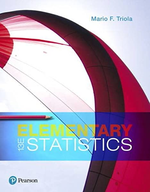?Finite Population Correction Factor If a simple random sample of size n is selected
Chapter 7, Problem 39(choose chapter or problem)
Finite Population Correction Factor If a simple random sample of size n is selected without replacement from a finite population of size N, and the sample size is more than 5% of the population size (n > 0.05N), better results can be obtained by using the finite population correction factor, which involves multiplying the margin of error E by \(\sqrt{(N-n) /(N-1)}\). For the sample of 100 weights of M&M candies in Data Set 27 “M&M Weights” in Appendix B, we get \(\bar{x}=0.8565 \mathrm{~g}\) and s = 0.0518 g. First construct a 95% confidence interval estimate of \(\mu\), assuming that the population is large; then construct a 95% confidence interval estimate of the mean weight of M&Ms in the full bag from which the sample was taken. The full bag has 465 M&Ms. Compare the results.
Text Transcription:
sqrt (N-n)/(N-1)
bar x=0.8565
mu
Unfortunately, we don't have that question answered yet. But you can get it answered in just 5 hours by Logging in or Becoming a subscriber.
Becoming a subscriber
Or look for another answer
